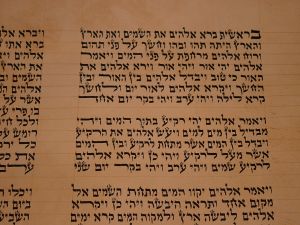
Section of séfer Torá (beginning of párašàt Berēshít) written on gevíl.
(©2005 Gevil Institute of Jerusalem.
Reproduced here with their permission).

| |
|
Section of séfer Torá (beginning of párašàt Berēshít) written on gevíl. |
Jerusalem, Israel, June 2005: As time goes by, important legal aspects of our Jewish faith appear to be fading away. Surprisingly, very few of our religious leaders seem to be aware of this phenomenon. One such example of this fading light involves the “institution” of gevíl animal hide, which is traditionally used as the authentic and required writing material in Torá scrolls.
Many of our grandparents still remember (with tears) the glow of their synagogue’s “gevíl” Torá scroll, as it was proudly shown to the congregants during the weekly and Shabbát prayers. Up until just one generation ago, gevíl had always been the standard type of animal hide used throughout the Sefaradí, Andalusí and Mizraḥí world. The former Sefaradí Chief Rebbí Mordechai Eliyahu Shlit”a still uses it. No one doubts its authenticity or accuracy, in terms of satisfying the Jewish Law beyond any doubt, better than any other material.
The antiquity and authenticity of gevíl can be verified from the Talmudic tractate Bava Batra (14b), which mentions how Moshè (Moses) used gevíl for the Torá scroll he placed into the Arón haqQódesh (Holy Ark). Also, in another tractate (Gittín 54b) we find mention that Torá scrolls were written on gevíl. HaRambam (Maimonides) said that non-gevíl Torá scrolls were problematic, because all scrolls are required to be processed with salt, flour and meŋafaṣím (wasp resin). He said that this is the law from Moshè as given on Har Sináy. Other supporters included haRambán, haRashbá and the Vilna Ga’ón.
Now, it has become necessary to re-publicise gevíl before it is too late. Unfortunately, many of our youngsters know little or nothing about the heritage of their grandparents. To answer this challenge, a new “Gevíl Revival” campaign to educate and preserve the institution of gevíl has been started by the Gevil Institute of Jerusalem. For more information about this authentic parchment legacy, you can visit their web site at www.globaljms.co.il. The Institute’s founder would be more than happy to answer any of your specific questions.
Ben Hhaim
Gevil Institute of Jerusalem
gawil@globaljms.co.il
Skrivarstuå
–
editor:
Olve Utne
Updated
16 June 2005 -
9 Siván 5765